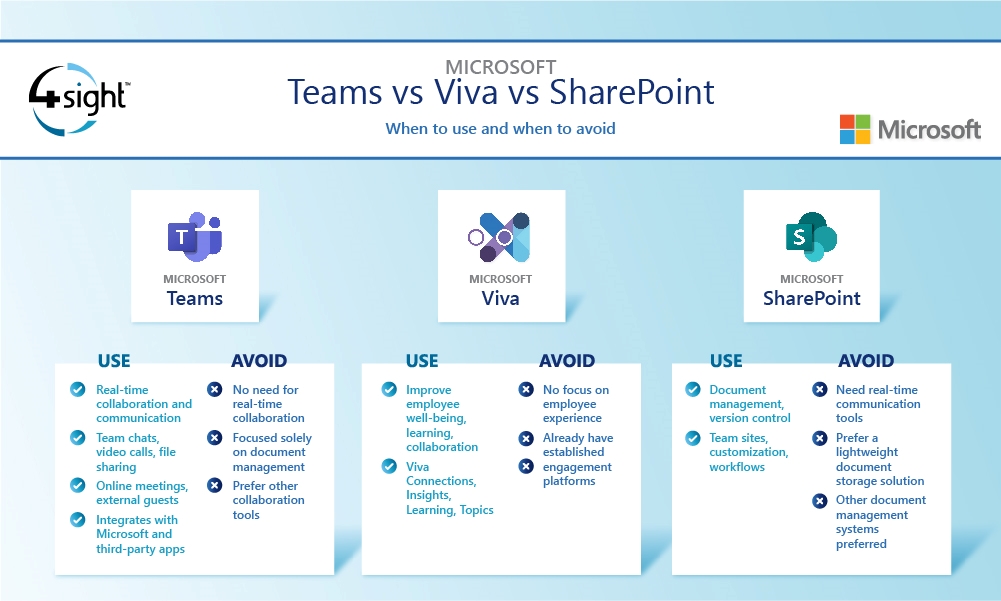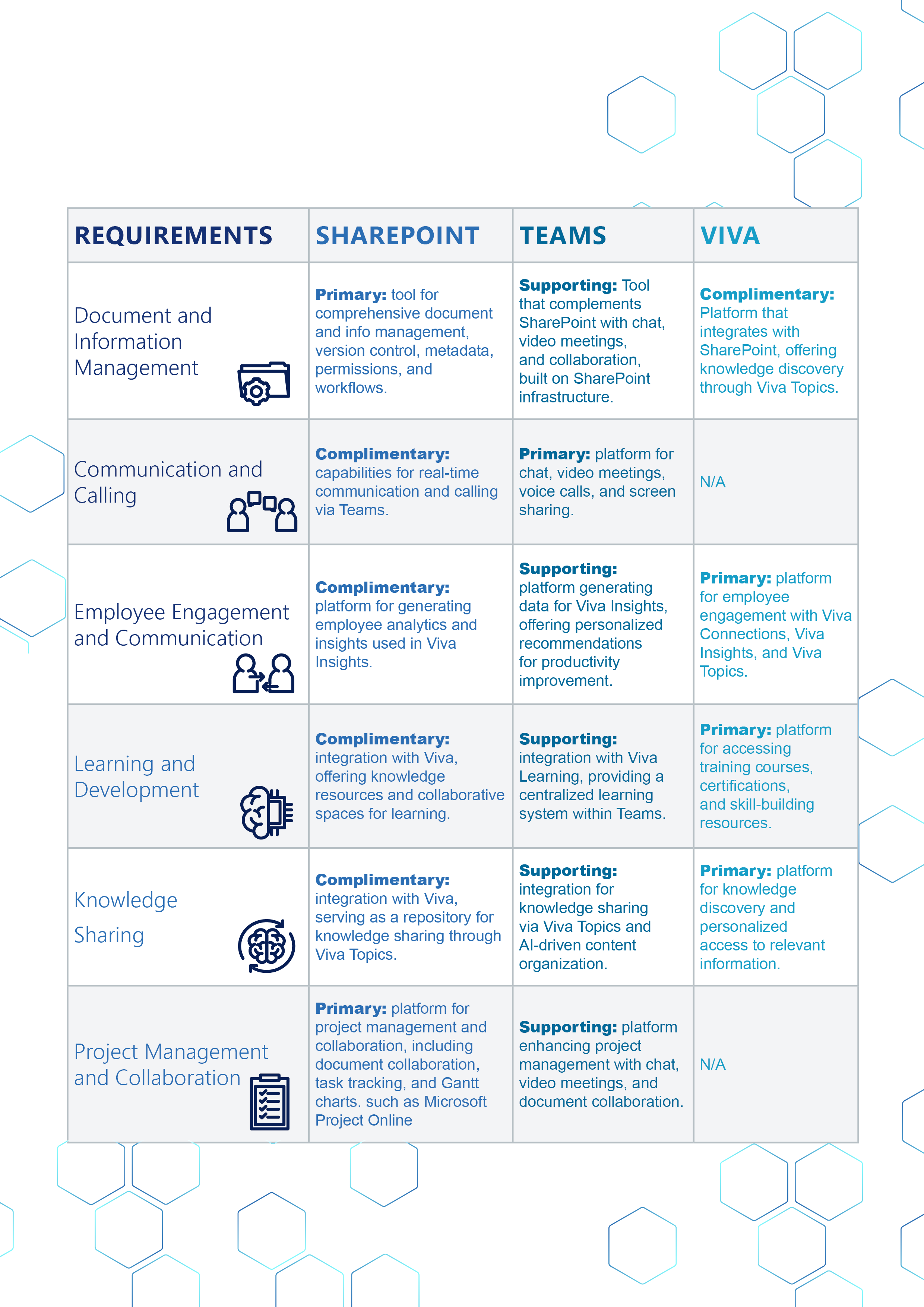Blog - Business Environment
Microsoft Teams, Viva, SharePoint: Knowing when and how to utilise these platforms in your organisation.

Three productivity applications
If faced with a choice of Viva and Teams, you might ask, “Why would I use Viva when I already use Teams extensively, on a daily basis? Why can I not just use Teams to manage my documents, does it not do the same thing?” This leads to an integral positioning of the three and whether any business actually needs all of them. If the answer is yes, then how best do we utilise each one, to get the most out of them. Many IT Leaders, as the ‘go to’ for investment and adoption of an organisation’s technology stack, have probably asked these questions. This blog post will help shed some light on this.
Let's first start off with a high-level explanation of what each of these three platforms offer:
MS SharePoint
SharePoint, originally introduced in 2001 and now a fully integrated cloud solution, is a comprehensive enterprise content management solution. It serves as a central hub for storing, organising, and sharing documents and resources, enabling collaboration and communication.
With customisable features, workflow automation, and AI capabilities, it intelligently manages content. SharePoint Online supports project management, robust search functionality, and the creation of customisable websites and intranet portals. It is a fundamental component of the Microsoft 365 suite, powering content storage and generation in Teams and Viva.
MS Teams
Microsoft Teams is a unified communication and collaboration platform launched much later, in 2017. It brings together people, conversations, files, and tools into a single workspace, facilitating remote collaboration. Teams offers real-time communication, file sharing, and simultaneous document collaboration. It integrates with other Microsoft 365 applications and includes audio/video conferencing with features like screen sharing and chat.
MS Viva
The most recent solution of the three introduced in early 2021, Microsoft Viva, is an employee experience platform that empowers organisations and individuals through a comprehensive digital platform. It consists of four ‘main’ modules: Viva Connections, Viva Insights, Viva Learning, and Viva Topics. Various other modules are also available and continuously being released by Microsoft.
Viva Connections provides a company-branded interface for accessing news and resources, while Viva Insights offers data-driven insights to improve well-being and productivity. Viva Learning centralises learning management, and Viva Topics uses AI to organise knowledge and facilitate content discovery. Together, these modules enhance engagement, productivity, and knowledge-sharing in the workplace.
Which ones do you need?
Now, let's look briefly when to use each of these in isolation but also in a scenario where you have all three in your environment. Like any platform out there, the reality is that it will depend on the type of work your organisation does and how employees create, collaborate and consume the content.

When and when not to use SharePoint
Here are some basic rules to apply to understanding whether SharePoint would be a good addition to your technology stack:
-
Organisation Size: The larger the organisation, the larger the volume of documents and need for structured information management, the greater the use case for SharePoint. In contrast, smaller organisations with minimal document collaboration requirements and smaller teams where informal communication is sufficient, may introduce more features and complexity than necessary.
-
Organisational Teams: When there are multiple cross-functional teams needing a central hub to share and collaborate on documents.
-
Internal Communications: When there is a need for Intranets and internal portals for communication and news with the ability for non-technical users to perform content management, custom branding and targeted content delivery. SharePoint is a good platform to address a requirement for an internal portal or intranet.
-
Compliance & Security: When the need for robust security and compliance capabilities such as data encryption, access controls, and audit trails and strict regulatory requirements are important to the organisation. Therefore, industries such as healthcare, finance, mining and manufacturing are typically good use cases.
-
Search: SrehaPoint Online includes powerful search functionality, enabling users to quickly find relevant documents, information, and expertise. This is particularly beneficial for companies with extensive content repositories or knowledge-based environments.
- Internal vs External Collaboration: SharePoint Online works best for internal collaboration within an organisation, whereas a requirement for frequent collaboration with external stakeholders, clients, or partners would make one of the other solutions more ideal.
When and when not to use Teams
- Teams makes a stronger use case in an environment where an organisation has remote and distributed teams as opposed to smaller teams that are office bound. Its most basic functionality such as chat and calls still work great for smaller distributed geographically teams though.
- Cross-functional and project-based teams: Teams provides a collaborative environment for cross-functional and project teams working on projects to enable communication, sharing of files, progress tracking and integration with other tools. For simpler team requirements where collaboration and continuous communication are not as relevant.
- Virtual meetings and web conferencing: Similar to the previous point, where you need teams to collaborate remotely and have frequent online meetings, webinars, training and presentations, Microsoft teams provides all that you would need in terms of web conferencing, screen sharing, and meeting recording capabilities. Smaller companies with more basic requirements will not benefit as much from these features.
- Integration with Microsoft 365 ecosystem: If your organisation has already invested in the rest of the Microsoft Cloud and have a need for a communications platform, MS Teams becomes a no-brainer as it seamlessly integrates with other Microsoft 365 applications such as SharePoint, OneDrive, Outlook, and more. Organisations using Google, Apple and Salesforce Amazon ecosystems should rather invest in like-for-like capability that these competitors offer if they would like to similar integration with the rest of their product suites.
- External collaboration and guest access: Teams supports guest access, enabling external stakeholders, clients, or partners to join and collaborate within a team. This feature is beneficial for those that frequently collaborate with external parties and need a secure platform for communication and document sharing.
When and when not to use Viva
- Access to Smart Devices: Unless your frontline or non-desk employees have access to computers or smart devices, you will not be able to reach these users using Viva. The platform relies heavily on digital access and user interactions, and employees with regular access to computers or mobile devices to be effective.
- Task-oriented or flexible: In roles where work is primarily task-oriented or repetitive, employees may not have the inclination to actively participate in the features provided by Microsoft Viva unless you are only using it to communicate with them. The opposite, where employees are doing majority of their work on computers and/or digital devices and where the type of work provides some agility and flexibility, makes Viva ideal.
- Organisational structure: Organisations that are highly autonomous or decentralised in structure or where the hierarchy is rigid, or communication is top-down may not require the extensive collaboration and engagement features provided by Microsoft Viva.
- Knowledge-intensive industries: Microsoft Viva emphasises knowledge sharing and collaboration which works great in organisations where there are various functional and domain knowledge owned by SMEs. However, in industries where research and development are a huge focal point, employees may prefer using dedicated knowledge management systems or industry-specific tools that are tailored to their unique work requirements - Viva's generalized approach may not meet their specific needs.
- Workforce Size: Smaller organisations with a limited number of employees may find the comprehensive features provided by Microsoft Viva to be excessive for their scale and introduce unnecessary costs.
So what if have the need for all three? Which do you use for what and how should they function together?
The below matrix should help with the decision:




